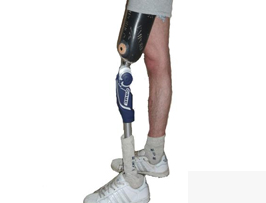Above-knee limb loss refers to amputation or absence of the leg above the knee.

Above-knee limb loss (also called transfemoral amputation) refers to amputation or absence of the leg above the knee. Although local processes and surgical preferences may vary considerably from person to person, individuals with an amputation above the knee usually begin the prosthetic fitting process several weeks after surgery. As you begin your rehabilitation process, you will work with a prosthetist who is trained in the design, fabrication, and fitting of prosthetic limbs. It is important to talk to your prosthetist about your expectations and concerns so he or she can address your specific needs. Your prosthetist will work closely with your physician and rehab team to monitor your health and help ensure you are meeting your expected milestones.
Here is an overview of what to expect during your above-knee limb loss care journey.
Post-Op Limb Care
After your amputation, you may experience substantial swelling in your residual limb. Your doctor may prescribe a shrinker to help shape your residual limb and ensure a better fitting prosthesis in the weeks ahead.
First Prosthetist Meeting
Your prosthetist will get to know you, evaluate your strength and mobility, and ask about your daily activities. He/she will listen to your goals and then apply their clinical expertise to design the right prosthesis, customized to your specific needs.
Initial Prosthesis
When your residual limb is sufficiently healed, you will be measured and fit with a prosthesis. The prosthesis you take home will be custom-made using materials most appropriate for your needs. Your prosthetist will teach you how to put on and care for your prosthesis and supplies.
Physical Therapy
Your physician, prosthetist, and/or physical therapist will help you learn how to use your prosthesis in your daily activities. Once you are comfortable with basic skills, you may be able to resume more advanced physical activities, such as walking up and down stairs, driving, and participating in sports or other and hobbies.
Follow-Up Care
As your limb changes, your prosthetist will continue to make adjustments to your prosthesis. This may include periodic replacement of the socket or replacing components as you increase your activity level. It is important to follow up with your prosthetist at least every six months to address any issues, especially as your residual limb is changing in size.